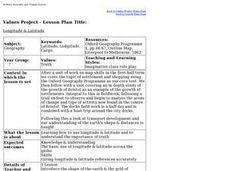Curated OER
Landforms
Students begin their examination of landforms. Using a map, they locate and identify the major landforms on Earth. They discuss how landforms affect the lifestyle of the community and determine which goods and services the community...
Curated OER
Fly on the Ceiling
Fourth graders complete activities to increase their understanding of coordinates. They listen to Julie Glass' book, The Fly on the Ceiling, before playing fly tic-tac-toe and Swat the Flies, in which they use ordered pairs to state the...
Curated OER
Real Life Challenge
Ninth graders read and examine narratives, review chronologies, consider ideas, and analyze trends in order to understand the past and present. In this American History lesson, 9th graders examine cause and effect, review chronologies,...
Curated OER
Sustainable Southern Belize: Coral Health Lesson Plan
Fifth graders investigate coral reefs and the dangers they face by labeling and drawing. In this oceanography lesson, 5th graders view a PowerPoint presentation of photographs of coral reefs in Belize. Students investigate and...
Curated OER
Longitude & Latitude
Seventh graders role play as ship's captains to study longitude and latitude.
Curated OER
American Robin: A Robin's Menu Through the Seasons
Young scholars read the article, A Robin's Menu Through the Seasons, taking notes and underlining key words and phrases. They create a math grid from the reading, research the animals in the article, and develop various writing assignments.
Curated OER
Great Questions for Tic Tac Toe
Fourth graders plan their own activities to reinforce the concepts being taught in school. The tic-tac-toe grid is used to help students create innovative learning activities to generate ideas.
Curated OER
Intrigued with Yo-Yos!
Fifth graders review the writing process and complete a research activity. In this writing process instructional activity, 5th graders research yo-yos online and write a research paper about the topic.
Annenberg Foundation
Teaching Geography: Workshop 4—North Africa/Southwest Asia
Can Jerusalem be equitably organized? Can Israel and Palestine be successfully partitioned? Part one of a two-part workshop looks at the geo-political history of Jerusalem while Part two investigates Egypt's dependence of the Nile River...
Curated OER
Landforms
Students study how landforms affect all aspects of a community. Students work in groups to identify landforms from other works of art. In cooperative groups Students select a work of art depicting a particular land form and create a poem.
Curated OER
Filling in the Picture
Students study archaeological sites. They discover some of the problems inherent in choosing sites and what parts are chosen for excavation. They evaluate and explain their choices for study and articulate the process of archaeological...
Curated OER
Issues About Rivers
Learners explore the environmental issues of rivers. In this river lesson, students collaborate to create a concept mat pertaining to environmental issues regarding the Tangipahoa River.
Curated OER
Graphing Coordinates
Sixth graders practice graphing coordinates. For this geometry lesson, they use the x and y axis to locate points that must be connected in the right sequence to form a straight line.
Curated OER
The Plains Indians
Young scholars have a better understanding of another culture other than their own. This help them to see that there were other people living in this region before us.
Curated OER
Using Geometric Shapes To Make Patterns
Sixth graders explore the use of shapes to create geometric patterns. they start with a simple example of dividing shapes in half to create two new ones. This can be extended to creating intricate patterns.
















